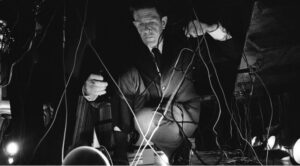
By: Austin T. Richey
In Michigan Opera Theatre’s 2015 production of Frida, production designer Moníka Essen brought the many experiences of Frida Kahlo to the stage, from her youth, to her rise as a painter, to her dreams and nightmares. Now, Frida returns to Detroit after a successful run of productions around the country, and with it, the costumes, props, and scenery that set the stage for the musical drama. I met with Essen at her studio and Michigan Opera Theatre’s Boll Hall to talk about revisiting Frida seven years later, and how Frida Kahlo’s tumultuous life encourages us to look for and to create the beautiful even in dark times.
“[Frida] lived through the pain, and she didn't give up. She looked inside herself and found the energy in the power to create amazing art through that. Coming out of COVID, we've got to remember that all of us can create amazing art. We may have been put on hold but we're back at it...we're making magic again. And that's what the show is about. It's about making magic.
“When I am designing costumes, I am not thinking about who the person is that's going to be wearing them. I'm not told who that is because we start designing at least a year in advance. I'm basically going: What's the flavor of the scene? What's the period? What do we want to convey?”
“I have designed everything: sets, costumes, properties. I've also done the projections, I've painted the show. Everything you see on stage, I've painted most of it. We started this process in 2015. And I was fortunate enough to be able to go to Mexico City. [Check out this video from the 2015 trip!] I was able to visit Casa Azul and actually see her studio, her paints, her wheelchair. Even her favorite nail polish! It was really a great insight into who she was as a person. She painted who she was, she painted her pain. And she painted her life.”

“A lot of [Frida’s] dress comes from the Oaxacan women. She chose to wear the clothing of a matriarchal society and that says a lot about her as a woman. You know, coming into her own power and into her own self, and choosing to wear that kind of clothing? Yes, it was to hide some deformities that she had from her accident. But also, it was a symbol of her power.”

“The women of Oaxaca do all of this embroidery. They actually made the garments, the whole thing. I wanted the traditional craftspeople to actually have a hand in it. Because she is their person. You know, she's very important to them. She's like their icon. She speaks for them.”

“We do have a different cast. I've redesigned some of the costumes to fit their bodies, but it's still in the same vein. We have characters like schoolgirls and school boys. Then they transform into revolutionaries, and then they transform into socialites. So we have many different sets of costumes for each person.”

Each character’s costume comes complete with a “ditty bag,” a labeled receptacle for their accessories.

One of the most striking elements of Essen’s work is Frida’s body cast. Over the course of her life, Frida was beset by illness and injury. Polio, gangrene, and a horrific bus accident warped and deformed her body, requiring the use of prosthetics and braces. Notably, the cast for Frida is modular; a blank cast, from Frida’s initial fitting, is a top plate that can be removed to reveal the colorful illustrations beneath. Nothing was off limits for the artist’s brush during her long periods of bed rest, including her cast.
“When you see [the cast], she's lying in her bed and she's painting it. I mean, I took liberties with it with color and shapes and things. [Frida] had over thirty-nine different casts. Because they kept changing, they would get disrupted, or in disrepair, and they'd have to make a new one. I took images from different [casts], and put them all on one. It's a conglomeration.”


“Each mask has a different design. We have two female dancers, so I did flowers on the top. For singers, we cut out the mouth so that they could sing. Then we have our monkey masks for when they're doing the crazy monkey dancing. There’s a part at the end where she's going in and out of pain and consciousness and it's a big dream sequence, it's very surreal. And then her paintings come to life and she's painting she's rapidly painting them as they're coming to life.”
“These [masks] are papier-mâché. Instead of the traditional Calaveras, sometimes portrayed just as skeletons, I thought it would be more magical and beautiful if they looked more like ghosts with the white garments and traditional Tehuana and Oaxacan garments. All the red ribbons that you see everywhere are because of all the red blood lines and ribbon-like blood in her paintings that connect her to all the parts of her life.”

“These are new additions this year. I had a friend of mine make these, they are 3D-printed. The Calaveras play them throughout the opera. They're very surreal and cool.”

During the opera, Rivera convinces a wealthy patron to purchase Frida’s paintings. For the current production, Essen updated the frames and easels to reflect the artist’s emergent fame. In this piece, “Memory and the Heart,” we see Frida between selves: as a child, as a young woman, and as a fierce representative of Mexican culture.
“I love this piece because it shows her caught between worlds. She's got one foot in New York and she wants to be back in Mexico.”
Michigan Opera Theatre is thrilled to present Frida, with the original cast including Catalina Cuervo as Frida Kahlo and Ricardo Herrera as Diego Rivera, this February 26th and 27th at Music Hall Center for Performing Arts, the original home of MOT.





